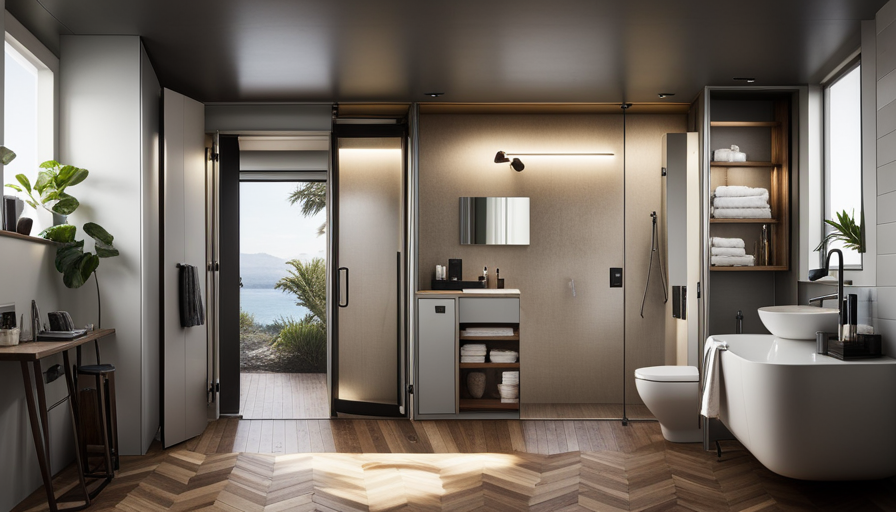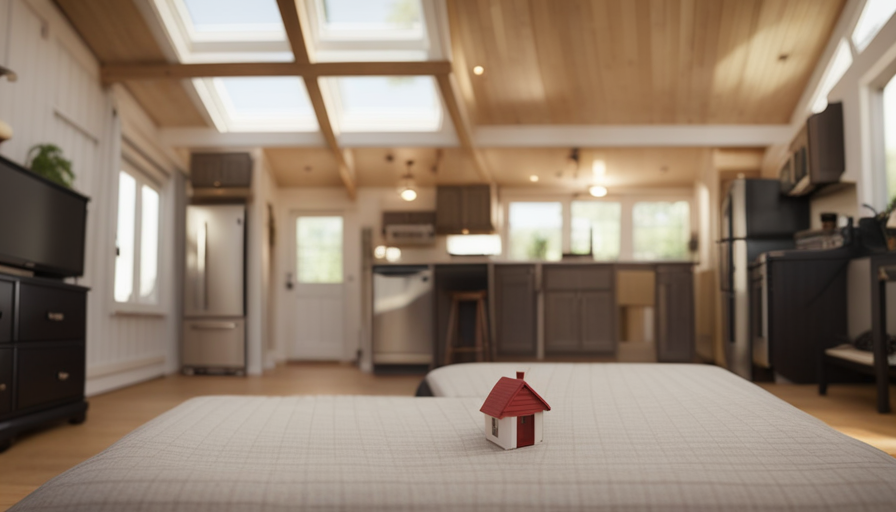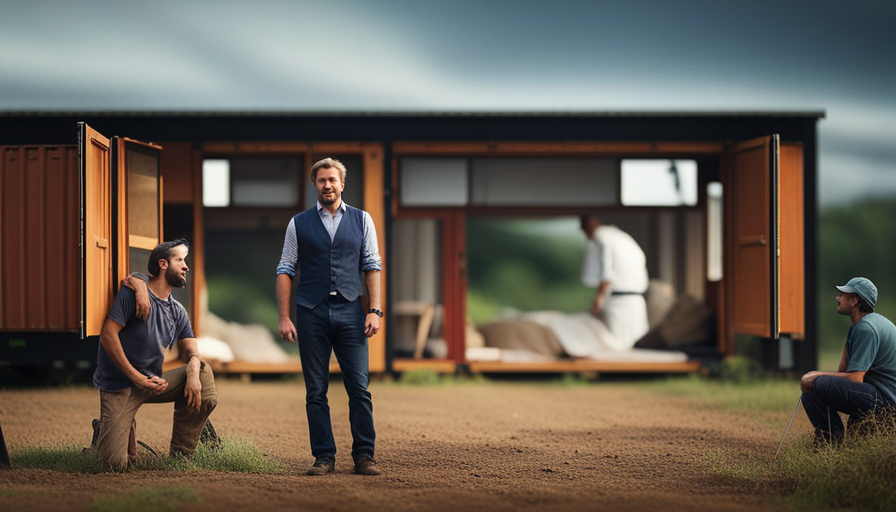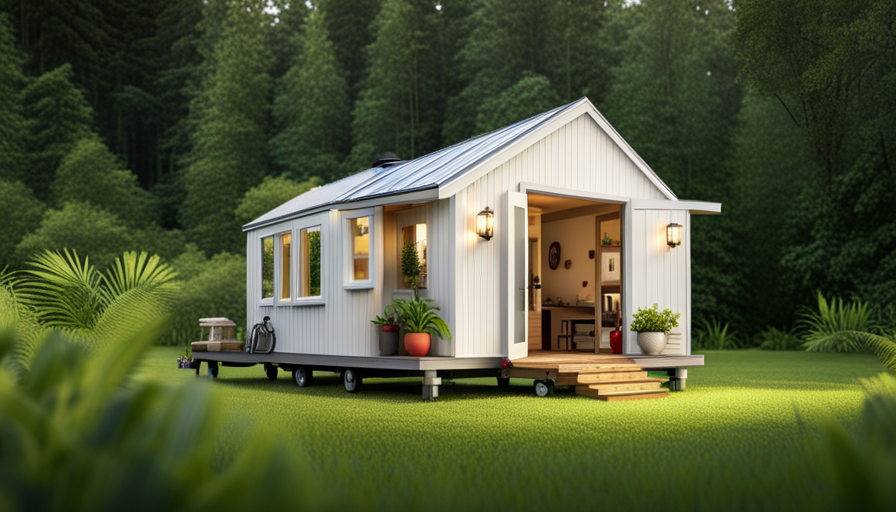In the world of tiny homes, where space is at a premium, maximizing every inch is crucial. The bathroom is a key area in a tiny home, requiring clever layouts and innovative solutions to optimize the limited space available.
When it comes to the size of a bathroom in a tiny house, it’s important to strike a balance between functionality and space optimization. This article will delve into the intricacies of designing a bathroom in a tiny house, exploring compact design ideas, plumbing considerations, storage options, privacy solutions, and tips for creating a comfortable and stylish space.
Whether you’re a tiny house enthusiast or simply curious about how bathrooms are designed in these unique dwellings, this article will provide you with the information you need to make the most of limited space. Get ready to discover the art of maximizing the bathroom in a tiny house.
Key Takeaways
- Tiny house bathrooms require efficient design and clever solutions.
- Striking a balance between functionality and space optimization is important.
- Wall-mounted fixtures and vertical storage maximize space.
- Water conservation is important in a small bathroom.
Understanding the Importance of Space Optimization
Space optimization is crucial when it comes to creating a functional and efficient bathroom in a tiny house. In such limited space, it’s important to utilize every inch wisely. Space-saving techniques can make a significant difference in the overall layout and functionality of the bathroom.
One effective approach is a minimalist bathroom design, which focuses on simplicity and functionality. By eliminating unnecessary elements and clutter, you can create a more spacious and open feel. This can be achieved by using wall-mounted fixtures, such as toilets and sinks, and incorporating storage solutions that maximize vertical space.
Additionally, using light colors and mirrors can help create an illusion of a larger space. With these space-saving techniques and a minimalist approach, you can create a compact bathroom that doesn’t compromise on functionality or style.
Now, let’s explore some compact bathroom design ideas.
Compact Bathroom Design Ideas
Not only does the itty-bitty lavatory in these minuscule abodes leave you feeling snug as a bug, but it also doubles as a well-camouflaged water closet. When it comes to small bathroom layouts in tiny houses, space optimization is key.
Here are some compact bathroom design ideas that make the most of limited space:
- Wall-mounted toilets: These fixtures save precious floor space and create a sleek, minimalist look.
- Corner sinks: Placing a sink in a corner utilizes otherwise unused space and creates a more open feel.
- Pocket or sliding doors: These space-saving doors eliminate the need for clearance, allowing for more usable floor space.
- Built-in storage: Incorporating shelves and cabinets into the walls maximizes storage without taking up additional room.
Considering these space-saving fixtures, it’s important to also think about plumbing and water supply in a tiny house bathroom. [Transition sentence into the next section about considerations for plumbing and water supply].
Considerations for Plumbing and Water Supply
To ensure a seamless and efficient bathroom experience, it’s crucial for you to carefully plan and consider the plumbing and water supply in your compact sanctuary. When it comes to plumbing installation, it’s important to work with professionals who have experience in tiny house construction. They can help you design a layout that maximizes space while still providing all the necessary amenities.
Additionally, water conservation should be a top priority in a small bathroom. Consider installing low-flow fixtures such as toilets and showerheads, as well as efficient faucets. These small changes can make a big difference in reducing water usage without compromising functionality.
By taking these considerations into account, you can create a bathroom that not only fits within the limited space of a tiny house but also promotes sustainability and efficiency.
Now, let’s explore how to maximize storage options in a small bathroom.
Maximizing Storage Options in a Small Bathroom
One way to make your compact oasis feel like a treasure chest of storage possibilities is by getting creative with organization solutions. Here are some storage solutions and space-saving techniques to maximize storage options in a small bathroom:
- Utilize vertical space with wall-mounted shelves or cabinets.
- Install hooks on the back of the bathroom door for hanging towels or robes.
- Use stackable bins or baskets to keep toiletries and bathroom essentials organized.
- Opt for a vanity with built-in drawers or shelves for additional storage.
By implementing these storage solutions and space-saving techniques, you can make the most of your tiny bathroom while keeping it organized and clutter-free.
And speaking of creative solutions, let’s move on to the next section to explore some innovative ideas for ensuring privacy in a tiny house bathroom.
Creative Solutions for Privacy in a Tiny House Bathroom
Privacy in a compact bathroom can be achieved through innovative solutions that maintain a sense of serenity and seclusion. When designing a tiny house bathroom, it’s important to think outside the box and explore creative storage solutions and alternative bathroom layouts. By maximizing the available space and utilizing clever design strategies, you can create a private oasis that meets your needs.
One option is to incorporate a sliding door or a pocket door for the bathroom entrance. This allows you to save space and maintain privacy when needed. Another idea is to use frosted or textured glass for the shower enclosure, providing privacy while still allowing natural light to filter through.
To further optimize space, consider installing wall-mounted shelves or adding storage niches in the shower area. This provides a convenient place to store toiletries and keeps the bathroom clutter-free. Additionally, utilizing vertical space with tall cabinets or built-in storage units can help maximize storage capacity.
By implementing these creative solutions, you can design a tiny house bathroom that offers both privacy and functionality. In the next section, we will explore how to design for comfort and functionality without compromising on space.
Designing for Comfort and Functionality
Creating a comfortable and functional space in a small bathroom can lead to a more enjoyable and stress-free experience, and studies have shown that a well-designed bathroom can improve overall well-being.
When designing a tiny house bathroom, it’s important to consider both aesthetics and relaxation. Incorporating natural elements, such as wood or stone accents, can create a calming and soothing atmosphere. Additionally, maximizing storage space with clever solutions like built-in shelves or hidden compartments can help keep the bathroom organized and clutter-free.
Choosing fixtures and fittings that are both practical and visually appealing is also key. For example, opting for a shower with a rain showerhead can provide a luxurious and spa-like experience. By focusing on the design elements that promote aesthetics and relaxation, you can create a tiny house bathroom that’s both functional and inviting.
Now, let’s move on to some final tips for creating an efficient and stylish tiny house bathroom.
Final Tips for Creating an Efficient and Stylish Tiny House Bathroom
To achieve an efficient and stylish bathroom in a limited space, it’s essential to carefully select multi-functional fixtures and utilize smart storage solutions. When it comes to efficient storage solutions, consider installing a vanity with built-in drawers and shelves, or a wall-mounted cabinet to maximize vertical space.
Utilizing hidden storage compartments within the walls or under the sink can also help keep the bathroom clutter-free. Additionally, incorporating eco-friendly bathroom options can contribute to a more sustainable tiny house. Consider using low-flow toilets and faucets to conserve water, and opt for energy-efficient lighting fixtures.
Installing a composting toilet or a greywater system can also reduce water waste. By combining efficient storage solutions with eco-friendly choices, you can create a functional and stylish bathroom without sacrificing space or sustainability.
Frequently Asked Questions
What are some common challenges when it comes to optimizing space in a tiny house bathroom?
When it comes to optimizing space in a tiny house bathroom, there are several common challenges that I’ve encountered. One space-saving tip is to utilize vertical storage options, such as installing shelves or cabinets above the toilet.
Another innovative solution is to use a compact vanity with built-in storage or a wall-mounted sink to free up floor space.
Additionally, choosing a shower stall instead of a bathtub can help maximize the available room.
How can I make the most of a compact bathroom design in a tiny house?
To make the most of a compact bathroom design in a tiny house, it’s essential to focus on space optimization. Start by choosing fixtures that are specifically designed for small spaces, such as a corner sink or a wall-mounted toilet.
Utilize vertical storage solutions like shelves or cabinets to maximize storage capacity. Consider using light colors and mirrors to create an illusion of spaciousness.
Lastly, make sure to prioritize functionality and organization to ensure every inch of the bathroom is utilized efficiently.
What should I consider when it comes to plumbing and water supply in a tiny house bathroom?
When it comes to plumbing considerations and water supply planning in a tiny house bathroom, there are a few key factors to keep in mind.
First, you’ll need to ensure that you have a suitable water source, such as a well or a connection to a municipal water supply.
Additionally, it’s important to plan the plumbing layout efficiently to maximize space and minimize the amount of piping needed.
Proper ventilation and insulation should also be considered to prevent moisture buildup and potential plumbing issues.
What are some creative ways to maximize storage options in a small bathroom?
When it comes to maximizing storage options and organizing small spaces in a bathroom, there are several creative ideas to consider.
Utilizing vertical space with shelves or cabinets can help maximize storage without taking up valuable floor space.
Installing hooks or racks on the back of the bathroom door can provide additional storage for towels or robes.
Additionally, using storage baskets or bins can help keep toiletries and other items organized and easily accessible.
How can I ensure privacy in a tiny house bathroom and what are some unique solutions for this issue?
Privacy is a top concern for tiny house dwellers, and finding unique solutions is essential. Did you know that 74% of tiny house owners prioritize privacy in their bathroom design?
To ensure privacy, consider options like frosted glass, sliding doors, or curtains. Space-saving techniques such as utilizing vertical storage, foldable fixtures, and hidden compartments can also create a more secluded and functional bathroom.
These solutions help maintain privacy without sacrificing precious space in your tiny house.
Conclusion
In conclusion, designing a tiny house bathroom requires careful consideration of space optimization, plumbing and water supply, storage options, privacy, comfort, and functionality. It’s important to make the most of the limited space available and utilize creative solutions to maximize efficiency.
Did you know that on average, a tiny house bathroom can be as small as 25 square feet? Despite its size, with the right design choices and smart storage solutions, it can still provide all the necessary amenities for a comfortable and stylish bathroom experience in a tiny home.
Hi, I’m Emma. I’m the Editor in Chief of Tiny House 43, a blog all about tiny houses. While tree houses are often associated with childhood, they can be the perfect adult retreat. They offer a cozy space to relax and unwind, surrounded by nature. And since they’re typically built on stilts or raised platforms, they offer stunning views that traditional homes simply can’t match. If you’re looking for a unique and romantic getaway, a tree house tiny house might just be the perfect option.










